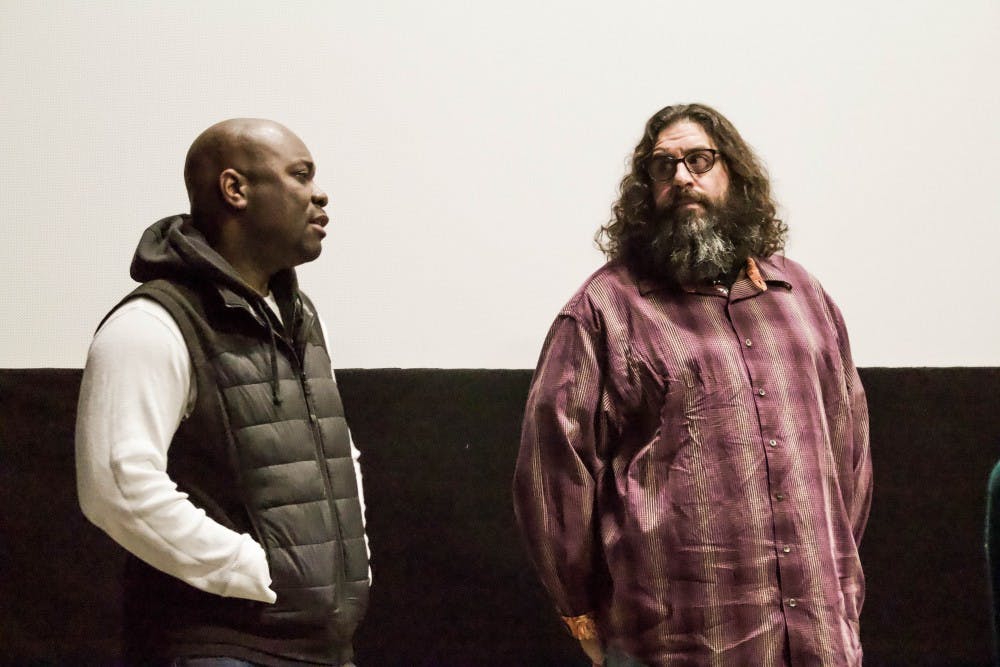CMU-produced Flint water crisis documentary shown at International Film Festival

Cedirc Taylor (left) and Eric Limarenko (right) discuss the film "Nor Any Drop to Drink" on Feb. 18 at Celebration Cinema.
Laughs, gasps and tears were among the reactions of audience members at a showing of "Nor Any Drop to Drink," a documentary about the water crisis in Flint, Michigan.
The film, written and directed by Central Michigan University assistant professor Cedric Taylor, played for two hours at Celebration Cinema on Feb. 18. The showing followed with a question and answer segment with Taylor, and producers, Eric Limarenko, a broadcast and cinematic arts faculty member, and senior Don Blubaugh. The showing was part of the 2018 Central Michigan International Film Festival, put on by the campus organization, Film Society.
Taylor described his emotions as he was watching the film on the big screen, and how he felt the various decisions he had made during the process were vindicated.
“You feel vulnerable because you’ve put so much work into it,” Taylor said. “You know the flaws and you pray that the audience won’t see them or be more forgiving of the flaws. It was a really good experience altogether, but it was scary at first.”
Other showings of the film will take place 6 p.m. on March 3 in the Charles V. Park Library Auditorium, and March 20 at Saginaw Valley State University.
The unscripted project began in Fall 2016, focusing on the ongoing water crisis in Flint that began in 2014. It begins with the financial issues that plagued Flint before the city’s water supply was switched to the Flint River, to now, three years later and the affect it continues to have on the community.
The film brings the water crisis to a humanitarian level — showing the struggles and emotions of everyday life for the citizens in Flint.
One audience member and faculty member for CMU’s global campus, Colleen Wilson-Rood, believes it is easy for people to become apathetic to the crisis when all that is shown is data, statistics and government reports. However, she thought “Nor Any Drop to Drink,” was able to show a more relatable side to the story.
“I think the most powerful thing about this documentary, and what’s going to grab people and get them to see and watch it, is the humanity,” Wilson-Rood said. “Bringing it down to the ground level — these are people just like you.”
“Nor Any Drop to Drink” also highlights key people involved with the crisis. Such as the researchers, testers of the water and political figures behind the problems and solutions, such as former Flint Mayor Dayne Walling and Melissa Mays, a public advocate for the crisis.
The opening scene of the documentary features a woman in Flint who is bathing herself with microwaved bottled water, baking soda and a wash cloth in her bathroom sink. The film closes with a scene from that same woman, a year later, who expresses her concerns of being scared, tired and upset about the state of the water in her home and neighborhood. She said she feared for the life of herself, her husband and her fellow community members.
“After a while I felt myself getting pulled into the film,” Taylor said. “I would from time to time look at the audience and see their reactions, because I know I responded to certain things in the film, that’s why I put them there in the first place. I was kind of hoping that other people would respond the same way, and for the most part they did.”
During the process of creating “Nor Any Drop to Drink,” Limarenko felt the heaviness of the subject weighing on him. During editing, his own water heater broke, and it put things into perspective for him.
“Am I going to complain the rest of the day because I don’t have hot water?” Limarenko said. “Literally I have hours and hours of (footage of) these people who are poisoned, who have to wash with bottled water – from making mac' and cheese to brushing your teeth – everything is a pain in the ass. And now I’m going to complain because my water heater broke?”
Limarenko wanted to create the same internal thought and contemplation within the people who watch the film.
“I want people to sit with the reality,” Limarenko said. “People are poisoned, children are poisoned, and it’s not getting fixed.”



